In Texas, the competitive spirit is not limited to sports. Can Early Music be a contender?
Rollin’ rollin’ rollin’, Raw-hide!
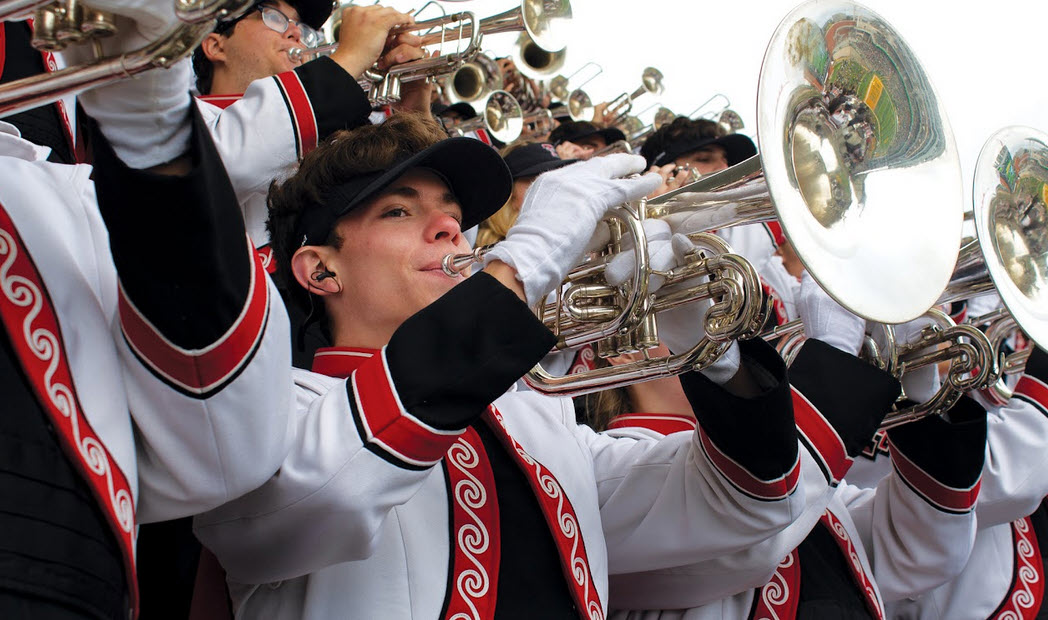 At Texas Tech University, the Goin’ Band from Raiderland, a marching band over 400 strong, was rehearsing the Rawhide theme just outside my office window, a crowd-pleaser for halftime at the Red Raiders’ football games. A few days earlier, along with a double-fortissimo Led Zeppelin medley, the band was practicing “New York, New York.” Led by Joel Pagán, they had been invited to march in the 2022 Macy’s Thanksgiving Day Parade.
At Texas Tech University, the Goin’ Band from Raiderland, a marching band over 400 strong, was rehearsing the Rawhide theme just outside my office window, a crowd-pleaser for halftime at the Red Raiders’ football games. A few days earlier, along with a double-fortissimo Led Zeppelin medley, the band was practicing “New York, New York.” Led by Joel Pagán, they had been invited to march in the 2022 Macy’s Thanksgiving Day Parade.
They are good—really, really good. And many of them have been marching in bands since they could hold a trombone. Why? Because Texas is among the strongest states in the country in the availability of music education, even as many school districts across the nation have seen the arts in public schools diminish for lack of funding and other support. The annual Texas Music Educators Association’s convention in San Antonio, which started in 1952 with 543 attendees, now regularly draws between 25 and 30 thousand attendees.
Despite this, early music in public schools, and even in many Texas colleges, is new territory. I went back to calling my Texas Tech group the “Collegium Musicum” after I had explained to at least a hundred Texans that the TTU Early Music Ensemble was not a practicum for the training of preschool-music educators. A large historical practice program like the one at the University of North Texas, with its vast instrument collection, multiple ensembles, and Baroque orchestra, is the exception. TTU’s collegium is small, fewer than 20 singers and instrumentalists, with subgroups that include Loud Band, recorder ensemble, and Medieval band. All are elective, although we offer a certificate in HP practice and research. Our school’s music education program, on the other hand, boasts 30-40 graduates annually and a nearly 100 percent job placement rate, a statistic that has held steady for at least two decades.
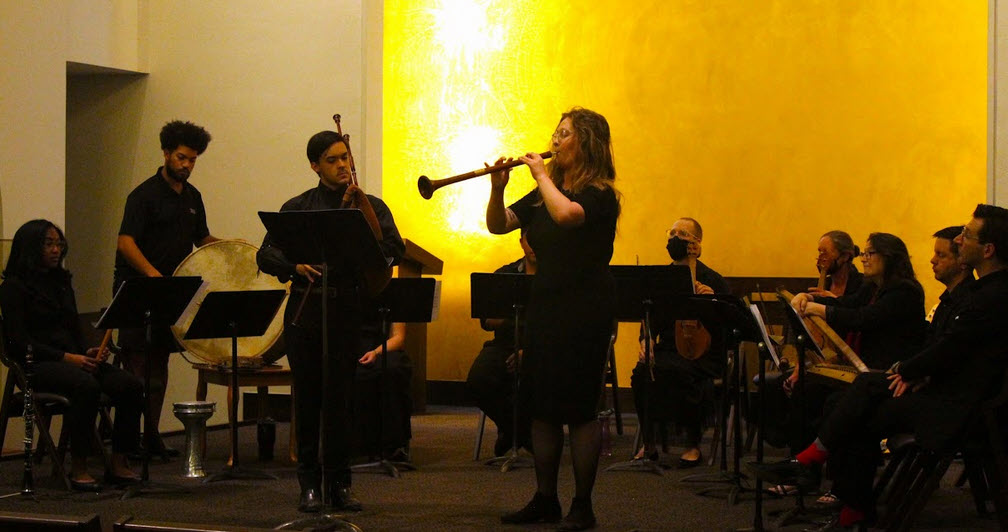
Educators everywhere should pay attention to the Texas model, which might soon be leading the way for how schools nationwide adopt and support music programs and might provide self-reflection for Texans eager to grow our own academic HP community.
The University Interscholastic League
The Texas mythos is strong: aggressive politics, guns, religion, border struggles, cowboys, ten-gallon hats, football, rodeos, scorching heat, Hank Hill, Dr. Pepper. While that iconic Texas does exist, along with the love-hate relationship it seems to provoke in the rest of the country, Texas’ booming population and 268,597 square miles comprise a number of distinct and very diverse regions. There is, however, one thing common to the collective psyche: they are very competitive.
Even Texans themselves joke about their obsession with sports, with the football gods at the top of Mount Olympus. But this competitive spirit is not limited to athletics. In the year 1910, at the University of Texas at Austin, an organization called the University Interscholastic League (UIL) was created to “provide educational extracurricular academic, athletic, and music contests,” with an original emphasis on debate and sports.
One hundred twenty-two years later, UIL is still going strong, as is its Platonic juxtaposition of physical, mental, and artistic competition, and this mindset has extended beyond Texas. Arts students and instructors take part in regional and statewide competitions, tournaments, and contests, with very specific rules and requirements for both the participants and the adjudicators.
Take, for example, the phenomenon of the One-Act Plays, a yearly event since 1927, through which UIL has managed to turn even theatre into a competitive sport. (And please note, in Texas it is theatre, not theater; our 1927 colleagues were clearly trying to signal legitimacy to the prevailing cultural hegemony.) The UIL website—www.uiltexas.org/theatre—describes this activity as the “largest high school play production contest or play festival in the world.” It is held on one day only and is open to the public. “The public” includes parents, who bring a Little-League level of competitive adrenaline and also pocket-watches that they use to ride herd on their little darlings’ rivals—in the event that some unfortunates disqualify themselves by going one second over the 40-minute limit.
Some may cringe, but consider these numbers, also from the uiltexas.org website:
More than 14,000 Texas high school students in more than 1,200 plays participate in 300 plus contests, which take place from the beginning of March through the 3-day, 40-production State Meet One-Act play contest . . . The League’s theatre program is considered by historians to be the foundation of educational and community theatre in Texas. It continues to be a major factor motivating increasing numbers of schools to offer theatre arts as an academic subject.
UIL has clearly provided a huge base of support for the arts in Texas public schools. But while a school’s high level of performance reflects well on both the instructors and the schools, the bad news is that a school’s low or middling performance also reflects on the system’s assessment of both the instructors and the schools.
This obviously raises issues of equality and inclusion, since some Independent School Districts (ISDs) simply do not have the tax base to be competitive. Many ISDs are also located in communities that are steeped in a rich cultural heritage—from indigenous, African-American, Mexican, and Central and South American traditions to the substantial Asian-American populations around Houston—that is not part of an ossified system of music education that privileges only the pillars of academic music programs: band, chorus, and orchestra.
Can the Texas UIL adapt as we become more sensitive to issues of diversity and inclusion? We might also ask, since our focus is early music: is there room in the public school system to grow historical instruments and repertoire, now embraced by the classical music world but still an outlier in public music education? Other programs (like mine) struggle for consistent enrollment because students cannot afford to pay expensive credit-hour fees for an elective ensemble that does not fulfill the institution’s requirements for a music degree.
To gain additional insight from a music-education specialist, I sought out my colleague Jacqueline Henninger, Associate Professor of Music Education and Associate Director for Teaching and Learning at Texas Tech. She underscores the connection between competition and financial support: some high schools in Texas have as many as five different band directors on staff, and even middle schools may have two or three.
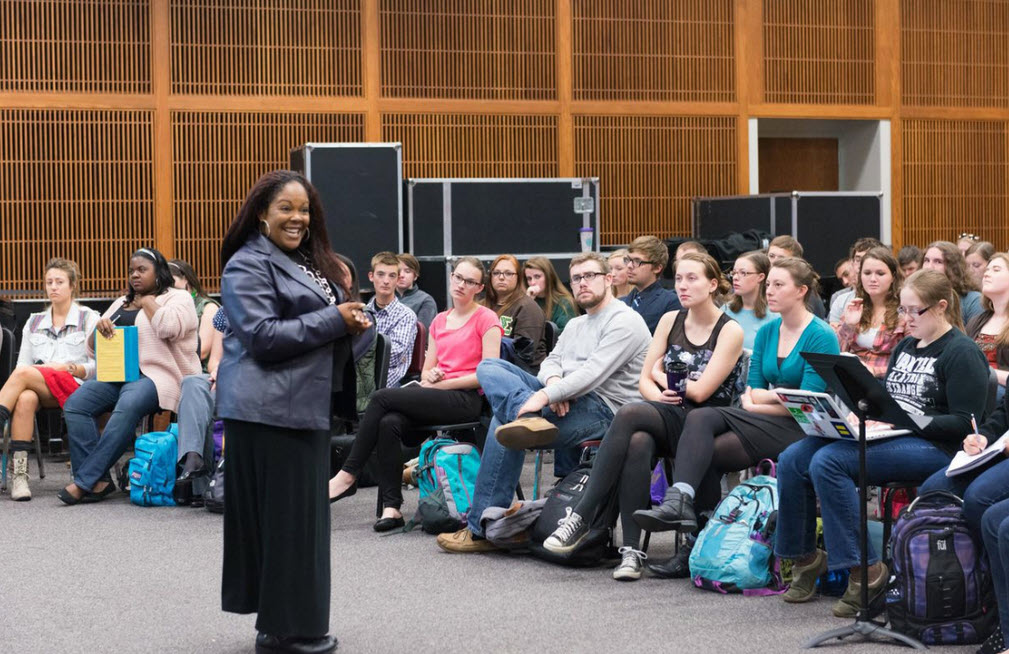
In Texas, football empowers instrumental programs. “There is a history of this connection across the entire United States to some degree, documented in music education texts,” says Henninger, “but this relationship is especially strong in Texas. If you don’t have a band, how are you going to get the crowds excited and get the team motivated to play?” It starts young, too, usually in middle school, moving on to Texas’ Friday Night Lights tradition of hugely attended high school football games. “To be honest, it would shock all of us if band programs were ever in jeopardy, because the football teams need to have the band.”
The symbiotic relationship between UIL, the established music-education system, and the culture of competition creates challenges for introducing historical instruments. “What Texas embraces when it comes to music in the schools is the most traditional of offerings: band, choir, and orchestra—and orchestra gets the least support of the three,” Henninger says. “They’re just starting to get on board with mariachi. Some programs have steel pan ensemble. Not enough have jazz.” These latter styles are often referred to in music education as “alternative ensembles.”
Ensembles specializing in early music, particularly with period-instruments, would certainly fall into the category of “alternative.” Many high schools have choral groups such as “madrigal singers,” but there is generally no expectation of historical vocal techniques and no exclusive adherence to early repertoire.
A model of access and community
As with classical music in general, often the greatest obstacle to introducing early music into school programs, especially in middle and high schools, seems to be access: to instruments, to skilled instructors, to live performances with period instruments.
Access and community support has certainly been successful for Pedro Funes and his students in the viola da gamba group Viols of the Creek, from Woodcreek Middle School and Summer Creek High School in Humble, just outside of Houston. Notably, Viols of the Creek was, to my knowledge, the first period-instrument ensemble to present at Texas Music Educators Association, in February of 2022.
“In Houston,” Funes told me, “we have early-music ensembles and a gamba organization, Viols of Houston,” which offers some financial assistance. (Funes is also the president of that organization.) “They support repairs and coaches to work with the students. I also take students to concerts with Houston Early Music, so they get more exposure.”
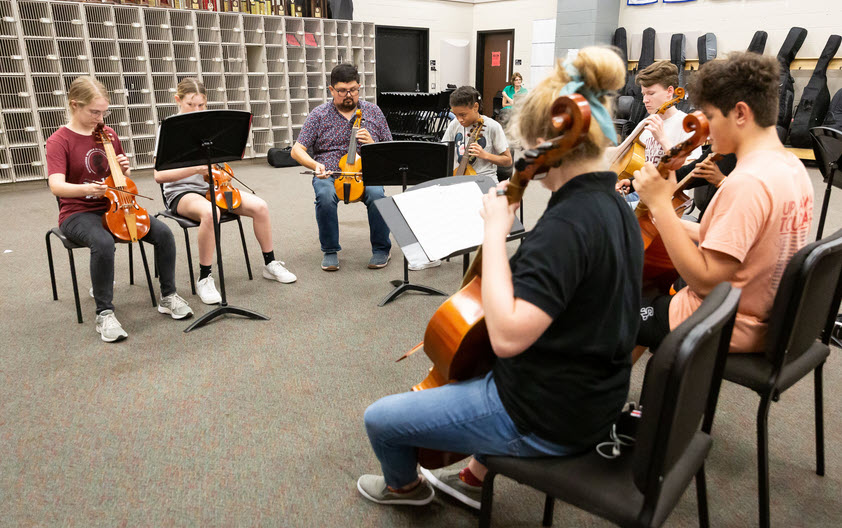
He has also taken young ensembles to perform at the Boston Early Music Festival, where they “get a chance to see what else is out there.” Funes has been working on “getting more exposure,” and of propagating opportunities for “this sort of ensemble to exist and be possible at a middle school.” Henninger agrees that being in a location that provides this kind of encouragement can make all the difference for a school early-music group. “Otherwise, it could be rough.”
The established music-education system also perpetuates access issues by privileging certain kinds of ensembles, which in turn privileges skill on the instruments needed for those ensembles. UIL therefore provides one kind of preparation for young musicians to compete in that world. However, prospective university students whose instrumental expertise lies in popular music, various global traditions—or, for that matter, shawm, viola da gamba, lute, or anything that cannot be put in band, choir, or orchestra—may receive the strong message that they Need Not Apply. The diversity and equity implications of this situation are abundantly obvious, as is the disincentive for a middle or high school to invest in instruments that are not included in UIL’s world.
Access to concerts by professional-level historical performance ensembles outside of Houston, Dallas, and Austin is also limited. The general lack of familiarity with early music often coalesces with audience reluctance to spend money on a ticket for something new or “different.”
This litany of obstacles, however, is not meant as a deterrent to action. I offer it instead to present the scenario with its challenges and suggest that even an unfamiliar seed may sprout in such fertile ground with effective initiatives.
While I do not believe that UIL is going to embrace period instruments or historical performance any time soon, Texas early-music educators can capitalize on the same things that keep UIL thriving: the value that Texas places on music in the schools, the competitive spirit of Texans, and the fact that Texas schools reward high-profile accomplishment. Pedro Funes has provided an inspiring example with Viols of the Creek, and one aspect of his success is his skill at giving his students access to early music while working in tandem with the system. He makes sure that “there are no performances close to UIL” on the calendar and organizes their time so that the viol ensemble can exist, and the students can also be successful at UIL. Strategically, Funes indicates that “the students are required to be in orchestra in order to be in viols.”
Just as a rural school with a tiny band can take part in UIL, we can create opportunities for historical performance in the smaller programs, including those at the post-secondary school level. In addition to the large early-music programs in Texas universities, like the University of North Texas, there are many in which one faculty person comprises the entire historical performance “program” in their school or university department, with an adjunct or two if they are lucky. They are often carrying the whole enterprise with little or no budget, while teaching a full courseload and attempting to fulfill research expectations. (I am one of these people, although Texas Tech’s School of Music also regularly brings in former Piffaro co-director Bob Wiemken to train our Loud Band, a huge plus for our program.)
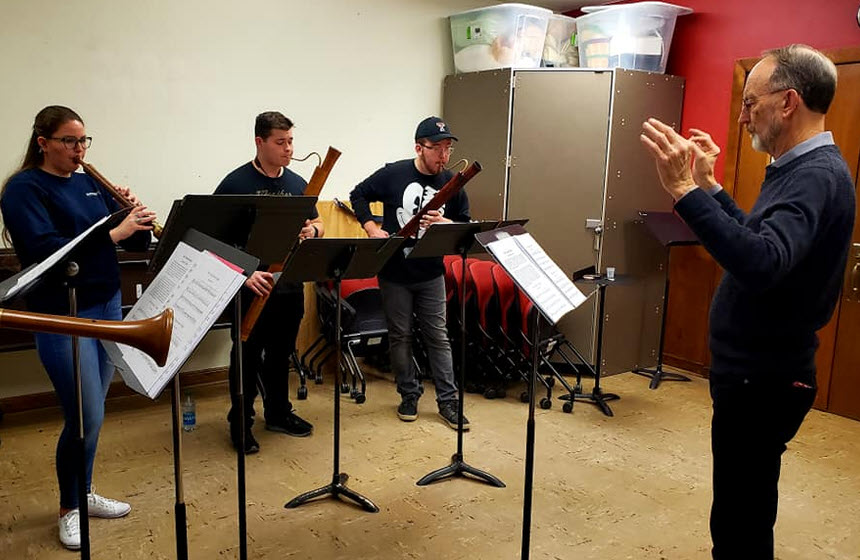
If we were not all working in silos, statewide early-music educators could support each other. We might consider advocating for the creation of the following:
- A Historical Performance Education Network for Texas that is inclusive of all levels, both university-level and K-12. I would suggest that we avoid the term “early music” in the title of the organization, because of the confusion with early childhood music education. I would also urge that we avoid using the HIP acronym (historically informed performance). The term is often experienced by our non-HP colleagues and educators as the elitist message that we are informed and thus they are not, even if that is not our intention.
- A regional Young Performer’s Festival. This would allow for greater inclusivity in experience and skill among performers from a more limited region. It would also serve to include students who have put forth extensive effort, but whose proficiency potential is limited because of the absence of enough early-music specialist faculty at their institution.
- Regional competitions featuring period instrument or early-music vocal competitions held in Texas, with either a cash prize or an opportunity for a high-profile performance or two.
There are also less ambitious activities that could be organized and promoted by regional organizations and institutions for both the communities and the student population of the Lone Star state:
- Public musicology lecture series with live musicians
- The inclusion of early-music performances in local concert series
- Partnering with local public schools to bring in musicians and instrument demonstrations
- Sessions for early-music educators at regional as well as national conferences (AMS Southwest, TMEA, etc.)
We can also investigate the use of language that is compatible with a culture of competition when communicating with funders, supporter organizations, and school districts. Has a school’s early-music ensemble been invited to participate in a festival, or have they won a place on the festival roster? You’ll raise a lot more travel money at the boosters’ buffet dinner with the latter.
‘Competition in the arts is not always a bad thing. Instead of branding it as toxic, perhaps we need to make friends with it’
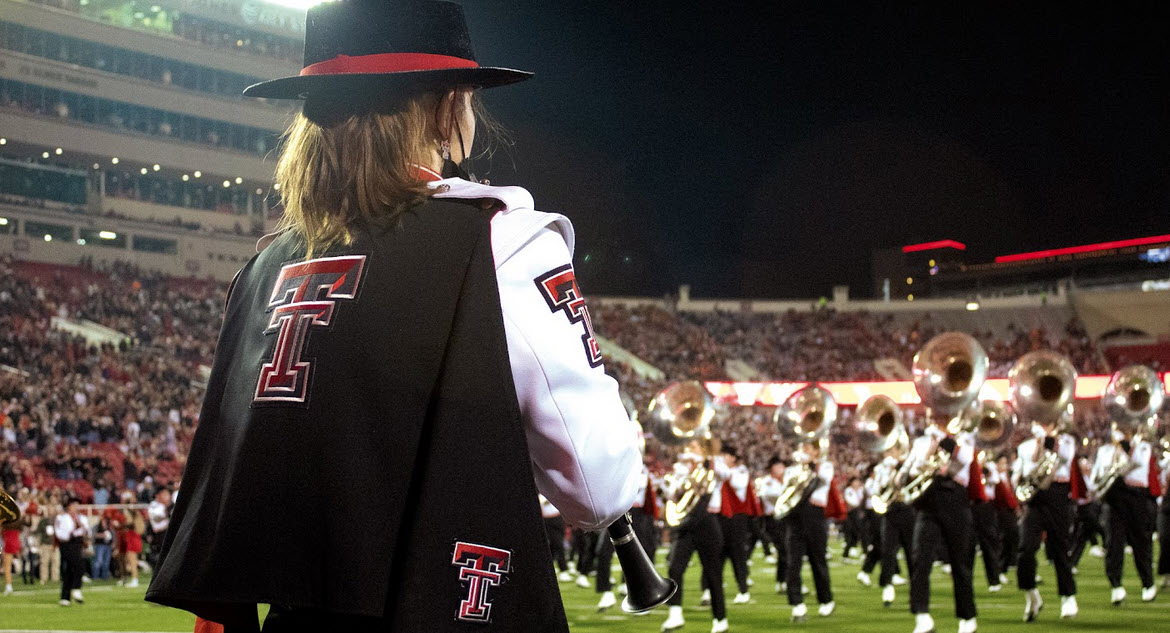
Finally, since Texas arts and competition have such a symbiotic relationship, I will close with a confession. As a musician who suffered from performance anxiety since childhood, I have grappled with grave reservations about the role of competition in the arts. The level of competition that arises by necessity in a culture in which artists must vie with each other for inadequate funding is already toxic; why should we reinforce this by holding competitions that single out artists for a reward of some kind, especially as young as middle school? Over the years, however, I have observed that many artists welcome the chance to compete because of the opportunities that result from the exposure. That, and the experience of living in a culture whose drive to compete has facilitated the continuing existence of arts programs, has convinced me that competition in the arts is not always a bad thing.
So instead of branding it as toxic, perhaps we need to make friends with it, work with it, and find ways to convey to our young artists that competition and a healthy sense of self-worth do not have to be mutually exclusive. In the meantime, might we envision a day when a large Loud Band could step out at a Texas Tech football halftime, dressed in the red-and-black-caped costumes of our mascot, and blow a couple of Tielman Susato tunes for the assembled multitude? I’m not sure that Texas Tech’s dubious football battle cry “Guns Up!” will ever become “Shawms Up,” but we can dream, can’t we?
Angela Mariani is Professor of Musicology and Director of the Collegium Musicum at Texas Tech University, and was the recipient of EMA’s 2017 Thomas Binkley Award. A founding member of Altramar medieval music ensemble, she has also hosted the syndicated public radio program Harmonia for 31 years.

